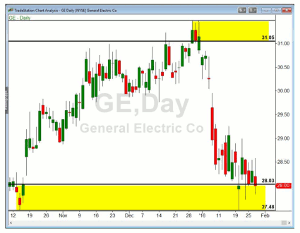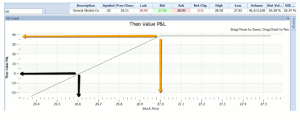Citing an example for support, options instructor Russ Allen of Online Trading Academy explains that technology has given options traders tools—such as the option payoff graph (or the risk graph)—which have made managing the moving parts of options trading easier.
When trading options, we have quite a few moving parts to juggle. Fortunately, technology now gives us tools that make this much easier.
One of those tools is the option payoff graph, also called the risk graph. We’ll take a look at this tool today.
We have been using the stock of General Electric for our examples recently, so let’s continue with that. Here’s how GE’s chart looked on January 27, 2016:
Let’s say we were neutral-to-bullish on GE and expected it to hold or go higher from here in the next few weeks. We might consider the trade that I described last week, which was to sell (short) put options for the February 19, 2016 expiration at the $27 strike price. These could be sold for $.39 per share or $39.00 per 100-share option contract.
To view the profit and loss possibilities of an option position, there is a standard format for portraying them graphically. The option payoff graph for this short put trade looks like this:
The gray line on this graph relates the stock price at the option expiration date to the amount of profit or loss that the option position would make with the stock at that price. The system knows that we would receive $39 when we sold the puts to enter the position.
These graphs take a little getting used to for those of us accustomed to using stock price charts. Note these points about the payoff graph:
- The price of the stock runs left to right (on the X or horizontal axis), not up and down on the Y or vertical axis, as price charts do.
- The vertical axis is profit or loss on the position at the indicated stock price.
- Not shown, but built into the graph, is the amount of money paid out or taken in to open the position. In our example, we sold puts for $39.00 for the contract.
- No time or movement is shown on the graph. The gray line is drawn as of a specific instant in time, the moment of option expiration, 23 days in the future. It shows what the amount of profit or loss would be if the stock were to be at the indicated price at that time.
In this case, the gray line slopes upward from left to right and then levels out at a profit of $39.00. This indicates that the maximum profit on the trade is $39.00 and that this would be the result if the stock were to be at any price at or above $27.00 at expiration. To read the entire article click here…
By Russ Allen, Instructor, Online Trading Academy























